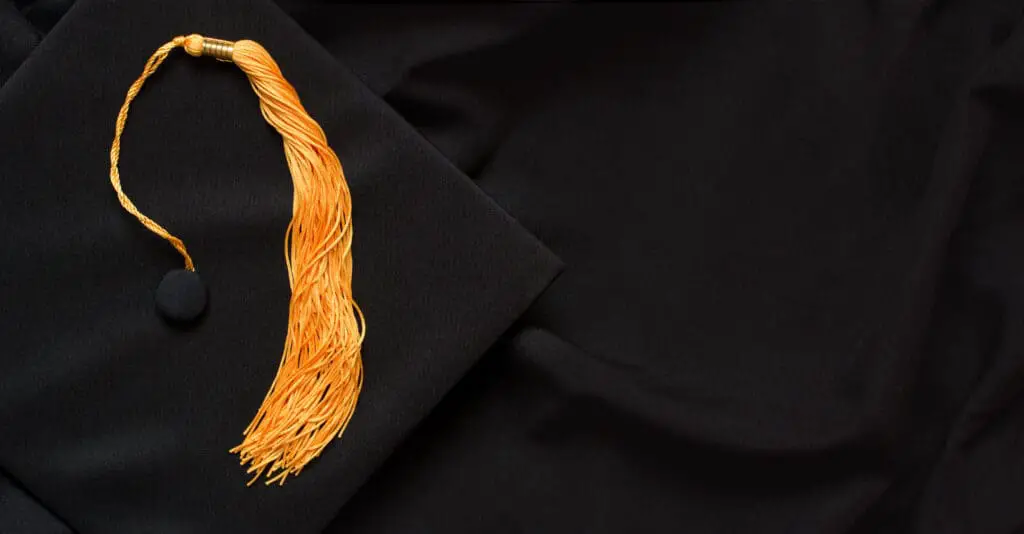College graduation is an exciting time for students who have worked tirelessly to earn their degrees. One of the many traditions associated with this milestone is wearing a graduation cap and gown, complete with tassels. However, there is often confusion about how many tassels to wear at college graduation and where to place them.
The number of tassels a student wears at their college graduation can vary depending on a few factors. One of the most significant factors is the type of degree they are receiving. For example, students earning a bachelor’s degree typically wear one tassel on the right side of their cap, while those earning a master’s degree wear a tassel on the left side. Additionally, some schools may have specific rules or traditions regarding tassel placement.
On graduation day, students take part in a commencement ceremony, which typically includes a procession, speeches, and the conferring of degrees. The ceremony is a time-honored tradition that marks the culmination of years of hard work and dedication. While the specifics of the ceremony may vary from school to school, the wearing of the graduation cap and gown, complete with tassels, is a universal tradition that is steeped in symbolism and meaning.
Understanding Academic Regalia
What is Academic Dress?
Academic dress refers to the traditional attire worn by faculty members and graduates during academic ceremonies such as graduations. The dress typically consists of a gown, hood, and cap. The gown is usually black and made of lightweight material, and its style varies depending on the degree being conferred. The hood is worn over the gown and is lined with the color of the institution conferring the degree. The cap, also known as a mortarboard, is typically black and has a tassel that hangs from the top.
History of Academic Regalia
The use of academic regalia dates back to the Middle Ages when scholars wore robes to keep warm in unheated buildings. Over time, the robes became more elaborate, and certain colors and designs came to signify different academic disciplines. In the United States, academic regalia was first used in the late 19th century, and it has since become an integral part of academic ceremonies.
The edging of hoods and velvet bars on gowns also have significance. The edging of hoods is typically a satin or silk material that represents the academic discipline of the degree being conferred. The velvet bars on gowns signify the level of the degree being conferred, with a single bar representing a bachelor’s degree, two bars representing a master’s degree, and three bars representing a doctoral degree.
White cords are also sometimes worn by graduates to signify academic achievement, such as graduating with honors. However, the use of cords varies by institution, and not all schools use them.
Overall, academic dress is steeped in tradition and symbolism, and it serves as a way to honor academic achievement and the pursuit of knowledge.
Components of Academic Regalia
Graduation Cap
The graduation cap, also known as a mortarboard, is a key component of academic regalia. It is typically made of black felt and features a flat, square top with a tassel attached to the center. The tassel is usually black, but it may be a different color depending on the school or degree program.
Gowns
The gown is another essential component of academic regalia. It is typically black and made of lightweight fabric, with long, flowing sleeves and a pleated front. The length of the gown may vary depending on the level of the degree being conferred.
Hoods
The hood is a unique component of academic regalia that varies depending on the degree being conferred. It is typically made of black fabric and lined with the official colors of the degree-granting institution. The length and shape of the hood may also vary depending on the degree being conferred.
When it comes to the specific types of academic regalia, there are a few key differences to keep in mind. Master’s gowns are typically shorter than doctoral gowns, and they do not feature the same type of fluting or trim. Doctoral gowns, on the other hand, are typically longer and feature velvet panels on the front and sleeves.
The edging of the hood is also an important consideration. The color and pattern of the edging may vary depending on the degree being conferred. For example, a hood for a degree in engineering may feature a gold stripe, while a hood for a degree in education may feature light blue.
Overall, academic regalia has a rich history that dates back to the Middle Ages. Today, it remains an important symbol of academic achievement and serves as a reminder of the hard work and dedication required to earn a degree.
Tassels and Their Significance
The Tradition of Tassels
Tassels have been an important part of graduation ceremonies for centuries. The tradition of wearing a tassel on a graduation cap began in the United States in the late 19th century. Originally, tassels were worn only by graduates of doctoral programs, but over time, the tradition spread to include graduates of all levels.
The tassel is typically worn on the right side of the cap before the degree is conferred. After the degree is conferred, graduates move the tassel to the left side of the cap. This is a symbolic gesture that signifies the transition from candidate to graduate.

Different Colors and Their Meanings
Tassels come in a variety of colors, and each color has a different meaning. Here are some of the most common tassel colors and their significance:
- Black: This is the most common tassel color and is worn by graduates of undergraduate and graduate programs in most fields.
- Gold: Gold tassels are often worn by graduates of business and management programs.
- White: White tassels are typically worn by graduates of nursing and other healthcare programs.
It’s important to note that the colors of tassels can vary by school and program, so it’s always a good idea to check with your school or program to find out what color tassel you should wear.
Turning of the Tassel
The turning of the tassel is a significant moment in the graduation ceremony. As mentioned earlier, graduates typically move their tassel from the right side of the cap to the left side after their degree is conferred. This is a symbolic gesture that signifies the transition from candidate to graduate.
Some schools have additional traditions associated with the turning of the tassel. For example, some schools require graduates to wait until a specific point in the ceremony to turn their tassel, while others allow graduates to turn their tassel at any point after their degree is conferred.
In conclusion, tassels are an important part of graduation ceremonies and carry significant meaning. Graduates should be sure to wear the correct color tassel and follow any additional traditions associated with the turning of the tassel.
Honors Cords and Stoles
What are Honors Cords?
Honors cords are a type of academic regalia worn at college graduation ceremonies. They are typically made of twisted cords of different colors and are worn around the neck. Honors cords signify that the wearer has achieved a certain level of academic excellence. They are often given to students who have earned a high-grade point average or who have completed a specific honors program.
Honors cords come in a variety of colors, with each color representing a different academic achievement. For example, a gold cord may signify that the wearer has graduated with honors, while a red cord may signify that the wearer has completed a specific honors program.
What is a Stole of Gratitude?
A Stole of Gratitude is a type of academic regalia worn at college graduation ceremonies. It is a decorative stole that is worn around the neck and hangs down the front of the gown. Stoles of Gratitude are typically given to students who wish to express their appreciation to someone who has supported them during their academic journey.
Stoles of Gratitude come in a variety of colors and designs. Some are plain, while others are decorated with symbols or words of gratitude. They can be customized to include the name of the person being honored, as well as the name of the student wearing the stole.
In conclusion, Honors cords and Stoles of Gratitude are an important part of college graduation ceremonies. They signify academic achievement and express gratitude to those who have supported students throughout their academic journey.

Wearing the Right Tassel
When it comes to college graduation, one of the most important decisions a student has to make is choosing the right tassel to wear. The tassel is an essential part of the graduation regalia, and it is important to wear the correct one to signify the level of degree that has been earned. Here are some guidelines for wearing the right tassel for different types of degrees.
Undergraduate Students
For undergraduate students, the tassel is worn on the right side of the graduation cap before the degree is conferred. After the degree is conferred, the tassel is moved to the left side of the cap. Undergraduate students wear a tassel with a single color that matches the school’s official colors.
Master’s Degrees
Master’s degree graduates wear a tassel that is a combination of two colors. The first color represents the school’s official colors, and the second color represents the graduate’s field of study. The tassel is worn on the left side of the cap throughout the ceremony.
Doctoral Students
Doctoral students wear a tassel that is similar to the master’s degree tassel with a few differences. The tassel is worn on the right side of the cap throughout the ceremony. After the degree is conferred, the tassel is moved to the left side of the cap. Doctoral students also wear a hood that represents their field of study.
In conclusion, wearing the right tassel is an important part of college graduation. Undergraduate students wear a single-color tassel that matches the school’s official colors, while master’s and doctoral students wear tassels with two colors that represent their field of study. By following these guidelines, graduates can ensure that they are wearing the correct tassel and representing their achievements accurately.
Other Considerations
When deciding on how many tassels to wear at college graduation, there are a few other considerations that students may want to take into account. These include student organizations, academic achievements, and faculty members.
Student Organizations
Some colleges and universities allow students who are members of certain organizations to wear additional tassels on their graduation caps. These organizations may include honor societies, fraternities, sororities, or other clubs. If a student is a member of one of these organizations, they should check with their school’s graduation office to see if they are eligible to wear additional tassels.
Academic Achievements
Students who have achieved academic honors, such as graduating with honors or earning a specific GPA, may also be eligible to wear additional tassels. The student’s school or department often determines this, so it’s important to check with the appropriate office to see if any additional tassels are allowed.
Faculty Members
In some cases, faculty members may be allowed to wear tassels on their graduation regalia. This may be in recognition of their years of service, their academic achievements, or their contributions to the school. If a student is unsure whether or not faculty members are allowed to wear tassels, they should check with their school’s graduation office.
Overall, when deciding on how many tassels to wear at college graduation, students should consider any additional honors or recognition they may be eligible for. By taking these factors into account, students can ensure that they are appropriately recognized for their achievements on their special day.
Conclusion
In conclusion, the number of tassels to wear at a college graduation ceremony varies depending on the degree being conferred. Students receiving an associate degree wear a single tassel on the right side of their cap, while those receiving a bachelor’s degree wear a tassel on the right side of their cap during the ceremony and switch it to the left side after receiving their diploma.
It is important to note that the tradition of wearing a graduation tassel dates back to the 14th century and has been a part of graduation regalia ever since. The tassel is often made of silk or other materials and is attached to a button on the top of the graduation cap.
While the number of tassels to wear may differ across different disciplines and cultural heritage, the basic tradition remains the same. The edging of the hood, which is also a part of graduation regalia, may also differ depending on the degree being conferred and the institution.
Overall, the graduation ceremony is a significant milestone in a student’s academic journey, and the wearing of the graduation tassel is an important symbol of their achievement.
